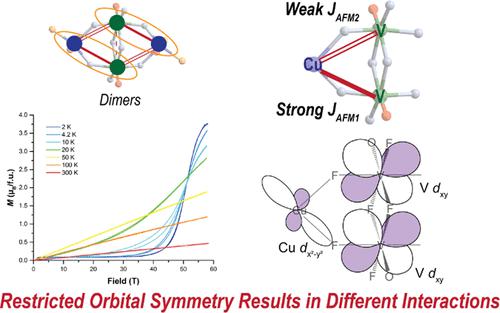当前位置:
X-MOL 学术
›
Inorg. Chem.
›
论文详情
Our official English website, www.x-mol.net, welcomes your feedback! (Note: you will need to create a separate account there.)
Two Distinct Cu(II)–V(IV) Superexchange Interactions with Similar Bond Angles in a Triangular “CuV2” Fragment
Inorganic Chemistry ( IF 4.6 ) Pub Date : 2022-06-23 , DOI: 10.1021/acs.inorgchem.2c01691 Yiran Wang 1 , Masayuki Fukuda 2 , Sergey Nikolaev 2 , Atsushi Miyake 3 , Kent J Griffith 1 , Matthew L Nisbet 1 , Emily Hiralal 1 , Romain Gautier 4 , Brandon L Fisher 5 , Masashi Tokunaga 3 , Masaki Azuma 2 , Kenneth R Poeppelmeier 1
Inorganic Chemistry ( IF 4.6 ) Pub Date : 2022-06-23 , DOI: 10.1021/acs.inorgchem.2c01691 Yiran Wang 1 , Masayuki Fukuda 2 , Sergey Nikolaev 2 , Atsushi Miyake 3 , Kent J Griffith 1 , Matthew L Nisbet 1 , Emily Hiralal 1 , Romain Gautier 4 , Brandon L Fisher 5 , Masashi Tokunaga 3 , Masaki Azuma 2 , Kenneth R Poeppelmeier 1
Affiliation

|
The strength and sign of superexchange interactions are often predicted on the basis of the bond angles between magnetic ions, but complications may arise in situations with a nontrivial arrangement of the magnetic orbitals. We report on a novel molecular tetramer compound [Cu(H2O)dmbpy]2[V2O2F8] (dmbpy = 4,4′-dimethyl-2,2′-bipyridyl) that is composed of triangular “CuV2” fragments and displays a spin gap behavior. By combining first-principles calculations and electronic models, we reveal that superexchange Cu–V interactions carry drastically different coupling strengths along two Cu–F–V pathways with comparable bond angles in the triangular “CuV2” fragment. Counterintuitively, their strong disparity is found to originate from the restricted symmetry of the half-filled Cu dx2–y2 orbital stabilized by the crystal field, leading to one dominating antiferromagnetic Cu–V coupling in each fragment. We revisit the magnetic properties of the reported spin-gapped chain compound [enH2]Cu(H2O)2[V2O2F8] (enH2 = ethylene diammonium) containing similar triangular “CuV2” fragments, and the magnetic behavior of the molecular tetramer and the chain compounds is rationalized as that of weakly coupled spin dimers and spin trimers, respectively. This work demonstrates that fundamentally different magnetic couplings can be observed between magnetic ions with similar bond angles in a single spin motif, thus providing a strategy to introduce various exchange interactions combined with low dimensionality in heterometallic Cu(II)–V(IV) compounds.
中文翻译:

三角形“CuV2”片段中具有相似键角的两种不同的 Cu(II)-V(IV) 超交换相互作用
超交换相互作用的强度和符号通常是根据磁性离子之间的键角来预测的,但在磁性轨道排列不平凡的情况下可能会出现复杂情况。我们报道了一种由三角形“ CuV _ _ _ 2 " 碎片并显示出自旋间隙行为。通过结合第一性原理计算和电子模型,我们揭示了超交换 Cu-V 相互作用在两条 Cu-F-V 路径上具有截然不同的耦合强度,在三角形“CuV 2 ”中具有相当的键角”片段。与直觉相反,发现它们的强烈差异源于由晶体场稳定的半填充 Cu d x 2 - y 2轨道的受限对称性,导致每个片段中一个占主导地位的反铁磁 Cu-V 耦合。我们重新审视了所报道的含有类似三角形“ CuV 2 _ _ _”片段,分子四聚体和链状化合物的磁性行为分别被合理化为弱耦合自旋二聚体和自旋三聚体。这项工作表明,在单个自旋基序中具有相似键角的磁性离子之间可以观察到根本不同的磁耦合,从而提供了一种在异金属 Cu(II)-V(IV) 化合物中引入各种交换相互作用以及低维数的策略。
更新日期:2022-06-23
中文翻译:

三角形“CuV2”片段中具有相似键角的两种不同的 Cu(II)-V(IV) 超交换相互作用
超交换相互作用的强度和符号通常是根据磁性离子之间的键角来预测的,但在磁性轨道排列不平凡的情况下可能会出现复杂情况。我们报道了一种由三角形“ CuV _ _ _ 2 " 碎片并显示出自旋间隙行为。通过结合第一性原理计算和电子模型,我们揭示了超交换 Cu-V 相互作用在两条 Cu-F-V 路径上具有截然不同的耦合强度,在三角形“CuV 2 ”中具有相当的键角”片段。与直觉相反,发现它们的强烈差异源于由晶体场稳定的半填充 Cu d x 2 - y 2轨道的受限对称性,导致每个片段中一个占主导地位的反铁磁 Cu-V 耦合。我们重新审视了所报道的含有类似三角形“ CuV 2 _ _ _”片段,分子四聚体和链状化合物的磁性行为分别被合理化为弱耦合自旋二聚体和自旋三聚体。这项工作表明,在单个自旋基序中具有相似键角的磁性离子之间可以观察到根本不同的磁耦合,从而提供了一种在异金属 Cu(II)-V(IV) 化合物中引入各种交换相互作用以及低维数的策略。



























 京公网安备 11010802027423号
京公网安备 11010802027423号